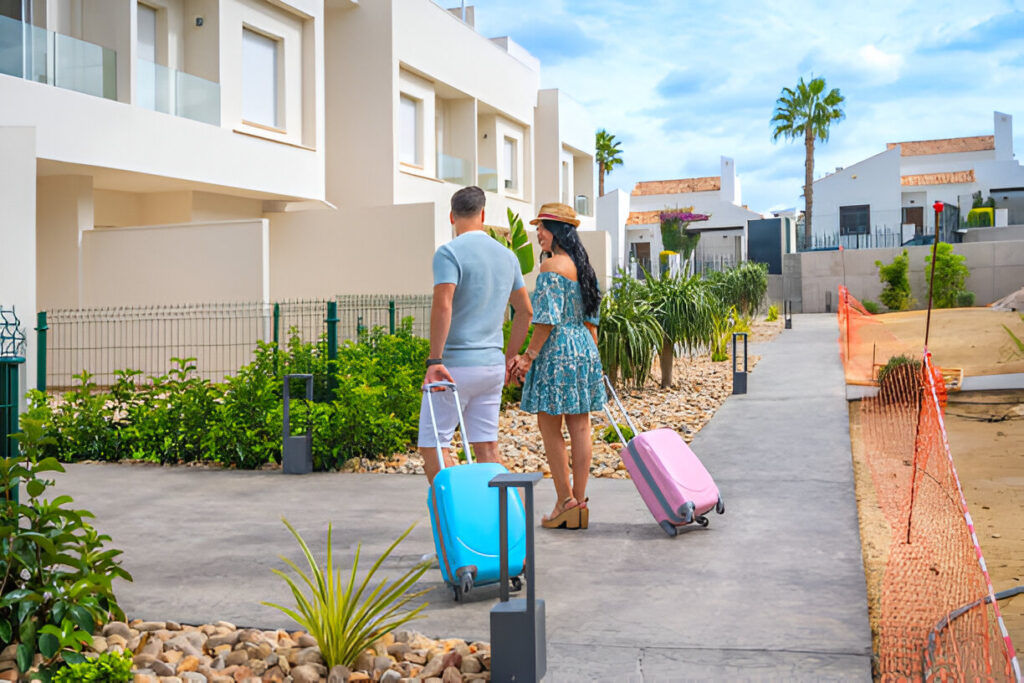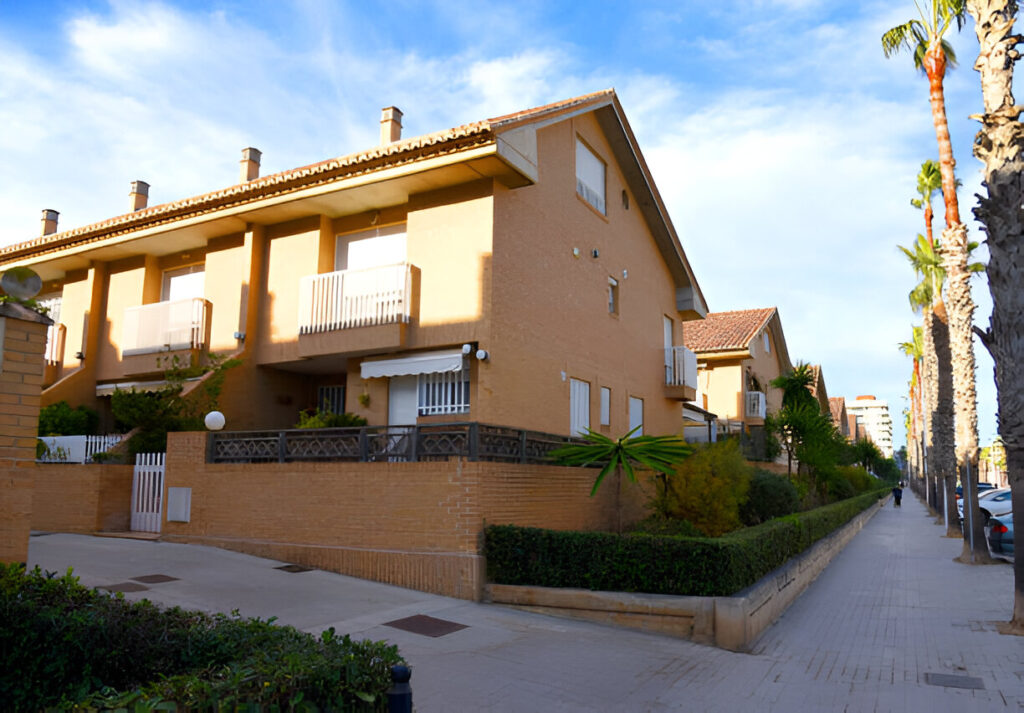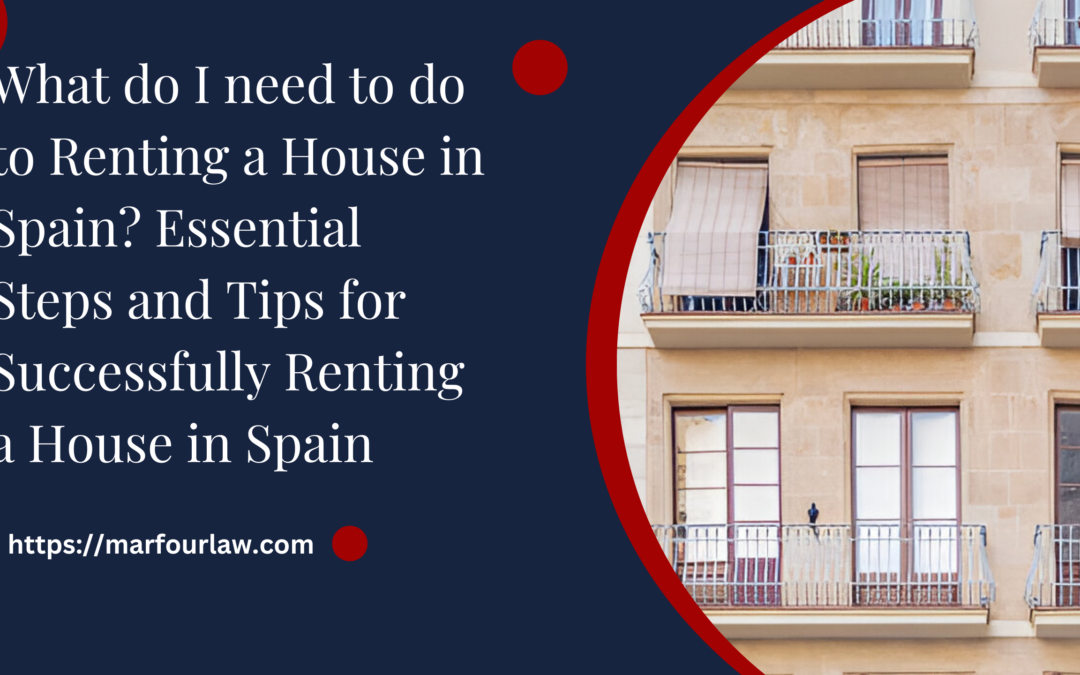Renting a house in Spain can be an exciting and rewarding experience. With its sunny weather, vibrant culture, and delicious food, Spain is a great place to live. However, as a foreigner, navigating the legal requirements and bureaucracy of renting a house in Spain can be overwhelming. In this article, Marfour International Law Firm will guide you through renting a home and obtaining a pardon in Spain.
What You Need to Know About Renting a House in Spain
Renting a house in Spain offers a fantastic opportunity to experience the country’s vibrant culture and beautiful landscapes. To help you navigate the process smoothly, here’s a comprehensive guide on what to consider when renting a property in Spain.
Finding the Right Location
Selecting the right location is vital when renting a house in Spain. The country’s diverse regions provide various living experiences, from the bustling energy of cities like Madrid and Barcelona to the serene ambiance of coastal towns and rural areas. Consider what kind of lifestyle you desire. Are you looking for a vibrant city scene or a peaceful retreat by the sea? Exploring different places can help you find the perfect spot that fits your needs and preferences.
Budgeting for Your Rental
Setting a budget is crucial in the rental process. Rental costs can differ widely depending on the location. Cities generally have higher rents compared to smaller towns or rural areas. In addition to the monthly rent, include additional costs such as utilities, maintenance fees, and community charges. Like planning for a significant purchase, you must ensure your budget covers all potential expenses to avoid surprises.
Reviewing the Rental Agreement
Before finalizing your rental, scrutinizing the rental agreement is essential. Agreements in Spain may differ from those you’re accustomed to, so it’s vital to know what’s included. Typically, you might need to pay a deposit equivalent to two month’s rent, and contracts are often for one year with options for renewal. Think of the rental agreement as a detailed guide—it lays out the terms of your rental arrangement, so make sure you are clear on all aspects before signing.
Handling Paperwork and Legal Requirements
Renting a house in Spain involves some paperwork. You’ll need to provide identification, proof of income, and possibly a reference from a previous landlord. If you are not an EU citizen, additional documents like a visa or residency permit may be required. Just as you would gather the necessary documents for a trip, make sure you have all the required paperwork to ensure a smooth rental process.
Moving In and Settling Down
After signing the agreement and completing the paperwork, it’s time to move in. Many rental homes in Spain come furnished, but you might want to personalize your new space. Make arrangements for utilities, internet, and any other services you need. Consider this step as making your new house feel like home—organize and set up your space to make it comfortable and functional for your lifestyle.
Building a Relationship with Your Landlord
Establishing a good relationship with your landlord can significantly enhance your rental experience. Clear communication is essential for addressing any issues that may arise. Think of your landlord as a partner in your rental experience; maintaining a positive relationship can help ensure that any problems are resolved quickly and that your stay is pleasant.
By following these steps, you can make renting a house in Spain straightforward and enjoyable. Embrace the experience and enjoy settling into your new home!
How do you search for a rental property in Spain?
When searching for a rental property in Spain, the internet is your best friend. Websites like Idealista, Fotocasa, and Kyero are great starting points. These platforms let you filter searches by location, price, and other features to match your preferences. It’s like having a virtual tour guide that helps you sift through options without leaving your home. Take your time exploring listings and save the ones that catch your eye.

Connect with Local Real Estate Agents
Sometimes, the best way to find a rental property is through local real estate agents who know the area well. They can offer insights you might not find online, such as neighborhood details and market trends. Reach out to agents in the area you’re interested in; they often have access to listings that haven’t hit the online platforms yet. Think of them as local experts who can help you find hidden gems.
Explore Neighborhoods in Person
While online searches and agent recommendations are helpful, nothing beats seeing a neighborhood in person. If possible, spend some time in the areas you’re considering. Walk around, visit local shops, and get a feel for the community. This hands-on approach helps you understand the area’s vibe and spot any potential issues with the property or location that you might not have noticed online.
Utilize Social Media and Expat Groups
Social media and expat forums are great resources for finding rental properties. Join local Facebook groups, forums, and online communities where people share housing opportunities and advice. You might find posts about available rentals or get recommendations from locals who know the best places to look. It’s like getting insider tips from people who’ve been through the process.
Be Prepared with Necessary Documentation
Once you find a property you like, preparing your paperwork can speed up the process. You’ll need identification, proof of income, and sometimes a reference or guarantor. Having these documents ready makes you look serious and organized, which can be a big plus when competing with other potential renters.
Check the Property Thoroughly
Before you commit to a rental, inspect the property carefully. Look for any signs of damage, check the condition of appliances, and ensure everything is in working order. It’s also a good idea to test things like water pressure and electrical outlets. This step is crucial to avoid any surprises after you’ve signed the lease.
By following these steps, you’ll be well on your way to finding a great rental property.
Where to Find the Best Place to Rent a Villa in Spain?
Finding the ideal villa to rent in Spain can feel like searching for a needle in a haystack. With so many beautiful regions to choose from, it helps to know where to start your search to find the perfect spot that fits your needs. Let’s dive into some practical tips and critical areas to consider.
Exploring Popular Spanish Regions for Villa Rentals
Spain offers a variety of stunning locations, each with its unique charm. The Costa del Sol is famous for its sunny weather and lively beach towns like Marbella and Malaga. This area is a top choice if you’re dreaming of a coastal retreat. On the other hand, the Balearic Islands, including Mallorca and Ibiza, are perfect if you’re looking for a mix of beautiful beaches and vibrant nightlife. For those who prefer a quieter countryside experience, the Andalusian region, with its charming villages and rolling hills, could be just what you’re looking for. Each region has its flavor, so consider what lifestyle you want when choosing a location.
Utilizing Online Rental Platforms
In the digital age, finding a rental villa has never been easier, thanks to online platforms. Websites like Airbnb, Vrbo, and Booking.com offer many options, from luxurious villas with private pools to cozy retreats tucked away in serene locations. These sites often have detailed descriptions, photos, and reviews from previous renters, which can help you understand what to expect. Don’t forget to use filters to narrow your search based on your preferences, such as location, size, and amenities.
Local Real Estate Agents and Agencies
Sometimes, the best way to find a villa is through local experts who know the area inside and out. Real estate agents in Spain can offer personalized recommendations based on your needs and budget. They might have access to properties that aren’t listed online or can provide insider tips on the best neighborhoods. Connecting with a local agent can save you time and effort, especially if you’re unfamiliar with the area.
Checking Regional Classifieds and Community Boards
Both online and offline, regional classifieds and community boards can be valuable resources. Websites like Idealista and Fotocasa feature a range of rental properties and often include local listings that may not be available on international sites. Community boards, whether digital or posted in local cafes and shops, can also have leads on rental properties directly from owners, potentially saving on agent fees.
Visiting the Area in Person
Visiting the area before committing to a rental can be incredibly beneficial. It allows you to experience the neighborhood firsthand, check out nearby amenities, and get a feel for the local culture. Plus, you’ll have the chance to see the villa in person, ensuring it meets your expectations. This visit can also give you a better sense of the property’s condition and surroundings, which might not always be clear from online listings.
Leveraging Social Media and Expats’ Networks
Social media platforms and expat communities can also be great resources when searching for a villa. Many expat groups on Facebook or forums like Expat.com have members who rent out properties or know of available rentals. These networks can offer firsthand recommendations and advice, which can be especially useful for moving to a new area or country.
By considering these strategies, you’ll be better equipped to find a villa that meets your needs and enhances your stay in Spain. Whether you’re drawn to the beaches, the countryside, or the vibrant city life, there’s a perfect spot waiting for you.
What Are the Best Places to Rent in Spain?
Renting in Spain provides diverse options, from its major cities’ lively streets to its coastal towns’ peaceful surroundings. Spain’s unique blend of culture, history, and modern amenities makes it an attractive destination for renters. Whether you’re drawn to the bustling energy of Madrid, the artistic and coastal vibes of Barcelona, or the historical allure of Seville, there’s something for everyone. Below, we explore some of Spain’s most popular rental destinations, highlighting what makes each area unique.

Madrid: The Dynamic Capital
Madrid, the capital of Spain, is a vibrant city known for its rich cultural heritage, energetic nightlife, and diverse neighborhoods. It’s a city that truly never sleeps, offering something for everyone, from historic sites to contemporary art, upscale shopping to casual tapas bars. Let’s look at some of the most popular neighborhoods in Madrid for renters:
- Malasaña: Located in the heart of Madrid, Malasaña is a lively and trendy neighborhood that has become synonymous with youth culture and creativity. This area has hip cafes, vintage shops, and a buzzing nightlife scene. The streets are often lined with street art, reflecting the area’s artistic flair. Malasaña is particularly popular with young professionals, students, and creatives who appreciate its alternative atmosphere and central location. Despite its vibrant nightlife, it has quiet corners offering a relaxed, community feel.
- Salamanca: Salamanca is the go-to neighborhood for a more refined and luxurious lifestyle. Known as one of Madrid’s most affluent areas, Salamanca is characterized by its broad, tree-lined avenues, elegant architecture, and a wealth of high-end boutiques and gourmet restaurants. The area is also home to some of the city’s most prestigious schools and medical centers, making it a favorite among families and expats looking for a sophisticated environment. The neighborhood’s blend of old-world charm and modern amenities provides a balanced and comfortable lifestyle.
- Lavapiés: Lavapiés is one of Madrid’s most culturally diverse neighborhoods, offering a rich mix of cultures worldwide. Historically, it has been a working-class area but has become a hub for artists, intellectuals, and those seeking a multicultural experience in recent years. Lavapiés is famous for its vibrant street art, numerous galleries, and a wide range of international cuisines, from Indian to African to Latin American. The area’s affordability and vibrant, eclectic atmosphere make it attractive to students, artists, and young professionals.
Barcelona: Where Urban Meets Coastal
Barcelona, known for its unique blend of urban life and coastal beauty, is one of Spain’s most popular destinations. It offers a variety of neighborhoods, each with distinct character and appeal. Whether you’re drawn to its stunning architecture, vibrant arts scene, or beautiful beaches, Barcelona has something to offer every type of renter.
- Eixample: Eixample is one of Barcelona’s most iconic neighborhoods, known for its grid-like streets and the stunning modernist architecture of Antoni Gaudí, including the famous Sagrada Familia and Casa Batlló. Eixample is a central neighborhood that balances history with modern living. It’s home to numerous shops, restaurants, and cultural attractions, making it a vibrant area always buzzing with activity. The wide streets and elegant buildings provide a spacious and comfortable living environment, making it popular among professionals and families who want to be close to the city’s heart.
- Gràcia: Once an independent town, Gràcia has retained much of its small-town charm despite being fully integrated into Barcelona. The neighborhood is known for its bohemian atmosphere, with narrow streets, independent boutiques, and a strong sense of community. Gràcia is famous for its local festivals, notably the Festa Major de Gràcia, where the roads are elaborately decorated. It’s a popular area for artists, students, and young families who appreciate its relaxed vibe and close-knit community feel. The area offers a more tranquil alternative to the busier parts of the city while still being close to major attractions.
- Barceloneta: If beachside living is what you’re after, Barceloneta is the ideal neighborhood. Barceloneta offers a laid-back lifestyle on the Mediterranean coast with easy access to the beach, seafood restaurants, and waterfront promenades. The neighborhood has a more casual, relaxed vibe than the city center, making it perfect for those who want to enjoy the sun and sea while still being just a short walk or bike ride away from the city’s main attractions. Barceloneta’s urban and coastal living blend makes it a favorite among locals and expats.
Seville: The Soul of Andalusia
Seville, the capital of the Andalusia region, is a city rich in history, culture, and tradition. Known for its stunning Moorish architecture, lively festivals, and passionate flamenco scene, Seville offers a more traditional Spanish experience. The city’s neighborhoods offer a unique slice of Andalusian life, making Seville a captivating place to rent.
- Santa Cruz: Santa Cruz is one of Seville’s most famous neighborhoods, known for its narrow, winding streets, whitewashed buildings, and beautiful courtyards filled with flowers. This historic neighborhood was once the city’s Jewish quarter and is now one of Seville’s most charming areas. It’s home to many of the city’s most famous landmarks, including the Seville Cathedral and the Alcázar Palace. Santa Cruz is perfect for those who want to live in the heart of Seville’s history, surrounded by stunning architecture and a lively atmosphere filled with tapas, bars, and flamenco performances.
- Triana: Located just across the river from the city center, Triana is known for its strong local identity and vibrant community life. Traditionally a working-class neighborhood, Triana is famous for its ceramics industry and the birthplace of many renowned flamenco artists. The area has a lively atmosphere, with numerous tapas, bars, local markets, and cultural events. It’s a great neighborhood for those who want to experience the authentic side of Seville, with a strong sense of tradition and community.
- Nervión: Nervión is a more modern neighborhood compared to the historic areas of Seville, offering a mix of residential living, shopping centers, and office spaces. It’s popular among professionals and families due to its excellent amenities, including schools, parks, and transport links. Nervión offers a more contemporary lifestyle while close to the city center. It’s a great option for those who want the convenience of modern living with all the benefits of being in a vibrant, culturally rich city.
These neighborhoods across Madrid, Barcelona, and Seville each offer a unique living experience, reflecting the diversity and richness of life in Spain. Whether you’re looking for a lively urban environment, a beachside retreat, or a historic neighborhood, Spain’s rental market has something to suit every taste and lifestyle.
What to Expect in a Spanish Rental Agreement?
Renting a property in Spain involves signing a rental agreement outlining the tenancy terms and conditions. Understanding what you’re agreeing to before signing the contract is essential. Here’s what you can typically expect in a Spanish rental agreement:

Basic Information
The rental agreement will include essential details such as the names of the tenant and landlord, the property address, and the rental period. It will also specify whether the contract is for a long-term (usually one year or more) or short-term rental.
Rent and Payment Terms
The contract will clearly state the amount of rent, how and when it should be paid (typically monthly), and any additional costs like utilities or community fees. It will also outline the payment method, which may be bank transfer, direct debit, or another form.
Deposit and Guarantees
In Spain, paying a deposit is standard, usually equivalent to one or two months’ rent, which is held as security against damages or unpaid rent. The agreement will specify the deposit amount, the conditions under which it can be withheld, and when it will be returned after the lease ends.
Duration and Renewal Terms
The lease duration will be specified, including the start and end dates. The agreement may also detail renewal options, notice periods for ending the lease, and conditions under which either party can terminate the lease.
Responsibilities for Maintenance and Repairs
The contract will outline who is responsible for maintaining the property. Typically, the landlord covers significant repairs (like structural issues or essential systems), while the tenant is responsible for minor maintenance tasks and keeping the property in good condition.
Inventory and Furnishings
The agreement should include an inventory list of the items provided if the rental is furnished. To avoid disputes later, it’s essential to check this list carefully and note any discrepancies before signing.
Subletting and Occupancy
Spanish rental agreements often include clauses about subletting or allowing others to live in the property. The contract will state whether subletting is permitted and outline any restrictions on the number of occupants.
Termination Clauses
The agreement will detail the conditions under which either the tenant or landlord can terminate the lease early. This may include specific notice periods and penalties for prematurely breaking the lease.
Understanding these elements of a Spanish rental agreement can help ensure a smooth renting experience and prevent potential disputes. Always read the agreement carefully and clarify any unclear terms before signing.
What is the First Step to Setting Up Utilities in Your New Home?
The initial step in setting up utilities is understanding which services are essential. Typically, this includes electricity, water, gas, internet, and sometimes waste management. Researching local providers and comparing their offers will help you choose the best options. Contact each provider to initiate service, and be ready to provide identification and proof of residence.
Researching Local Utility Providers
Start by researching the utility providers available in your new area. This includes electricity, water, gas, and internet services. Look into their pricing, customer service reviews, and any special offers. Comparing different providers will help you make an informed decision.
Gathering Necessary Documentation
Before you contact utility providers, gather the documents you’ll need. Typically, you’ll need to provide identification, proof of your new address (like a lease or purchase agreement), and possibly a deposit. Having these ready will speed up the process.
Contacting Utility Providers
Once you’ve chosen your providers, contact them to set up your services. You can usually do this online, by phone, or in person. Please provide them with your move-in date, personal details, and the required documentation. If installations are needed, schedule them as soon as possible.
Scheduling Service Start Dates
Coordinate with your utility providers to ensure services like electricity, water, and internet are active by your move-in date. It’s a good idea to arrange for these services to start a day or two before you move in so everything is ready when you arrive.
Reviewing Service Agreements
Before finalizing your setup, carefully review each provider’s service agreements. Check the rates, contract terms, and any additional fees. If anything is unclear, ask the provider for clarification to avoid unexpected charges on your bill.
12 Tips to Make Renting in Spain Easier and More Secure
Renting a property in Spain can be exciting, but it’s essential to be aware of specific aspects that can help make the experience smooth and successful. Here are 12 detailed tips to help you navigate the rental process in Spain effectively:

Research the Local Rental Market Thoroughly
Before you decide on a rental property, take the time to research the local market in the area where you plan to live. Rental prices can vary widely between cities and even within different neighborhoods of the same town. Use online platforms, local real estate agents, and community forums to understand the going rates. Understanding the market will help you avoid overpaying and identify fair deals.
Examine the Rental Contract Carefully
Rental contracts in Spain can differ significantly from those in other countries, with unique clauses and conditions. It’s crucial to read the contract carefully before signing. Pay close attention to the terms related to the duration of the lease, the deposit, maintenance responsibilities, and any potential penalties. If anything is unclear, it’s wise to consult a lawyer who can explain the terms and protect your rights.
Inspect the Property’s Condition Before Moving In
Conduct a thorough inspection of the property before you move in. Look for any damages, wear and tear, or maintenance issues. Take detailed photos and notes of anything that looks problematic, and send these to the landlord to have a record of the property’s condition at the start of your lease. This can prevent disputes about damages when you move out.
Be Prepared for Additional Costs Beyond Rent
When budgeting for your rental, remember that the monthly rent is just one part of your total housing expenses. You’ll likely need to cover utilities such as electricity, water, gas, internet, and community fees if the property is part of a building with shared facilities. Some landlords also require tenants to pay for property maintenance. Clarify with the landlord what is included in the rent and what additional costs you will be responsible for.
Familiarize Yourself with Tenant Rights in Spain
Understanding your rights as a tenant in Spain is essential for protecting yourself from unfair practices. For example, Spanish law requires landlords to give tenants at least two months’ notice before eviction, and there are regulations that limit the rent’s increase each year. Knowing your rights will help you handle any issues during your tenancy.
Document All Agreements in Writing
It’s essential to get any agreements with your landlord in writing. This includes agreements about repairs, any alterations to the property, rent adjustments, and other terms not covered in the original contract. Having these details documented will protect you in case of any misunderstandings or disputes later on.
Set Up Your Utility Accounts as Soon as Possible
After signing the rental contract, arrange for electricity, water, gas, and internet to be connected before you move in. In Spain, setting up utilities can take some time, so starting this process early ensures that everything will be ready when needed. Moving into a home without essential services will save you the inconvenience.
Check the Energy Efficiency of the Property
Energy costs can be a significant part of your monthly expenses, especially during the hot summers and cold winters in Spain. When viewing properties, ask about the energy efficiency of the building. Look for features like double-glazed windows, proper insulation, and energy-efficient appliances, which can all help reduce your utility bills.
Consider the Location’s Convenience
The location of your rental property will significantly impact your daily life. Consider how close the property is to your workplace, schools, grocery stores, public transportation, and other amenities. A more convenient location might be worth paying a slightly higher rent, as it can save you time and money on transportation and make your day-to-day life easier.
Be Cautious of Rental Scams
Rental scams are unfortunately common, especially in popular tourist areas or major cities. Be skeptical of deals that seem unusually cheap or too good to be true. Never send money before you’ve had the chance to view the property in person and verify the legitimacy of the landlord. Use reputable rental agencies and platforms to reduce the risk of falling victim to a scam.
Don’t hesitate to Negotiate the Rent.
In many cases, landlords in Spain are open to negotiating the rent, especially if you’re willing to sign a longer lease or move in quickly. Don’t be afraid to ask for a lower price, request additional amenities, or ask the landlord to cover some extra costs, like utilities. Successful negotiation can lead to significant savings over time.
Consider Opening a Spanish Bank Account
Opening a Spanish bank account is highly recommended if you plan to stay in Spain for an extended period. It simplifies paying rent and managing other local expenses. Some landlords require rent payments from a Spanish account, so having one can make your rental experience smoother and more convenient.
FAQs on Renting a House in Spain
What documents do I need to rent a house in Spain?
Typically, you’ll need your passport or ID, proof of income (like a job contract or bank statements), and sometimes a reference letter from a previous landlord. You might also need a residence permit or visa if you’re not an EU citizen.
Do I need a Spanish bank account to rent a house in Spain?
While not always mandatory, having a Spanish bank account can make the process easier, especially for paying rent and utilities. Some landlords may require payments through a Spanish account.
How much is the security deposit when renting a house in Spain?
The security deposit is usually equivalent to one or two months’ rent. This deposit is returned at the end of your lease, provided there are no damages or outstanding bills.
Can I negotiate the rent price?
Yes, it’s often possible to negotiate the rent, especially if you’re planning to stay long-term or if the property has been on the market for a while. It’s always worth asking!
Conclusion
Renting a house in Spain involves understanding local procedures, being aware of potential additional costs, and ensuring you have all the necessary documentation. Researching the market, inspecting properties, and negotiating terms can help you find the right home and provide a smooth rental experience. Whether you’re a resident or a non-resident, following these steps will help you navigate the rental process confidently and make your stay in Spain enjoyable.

